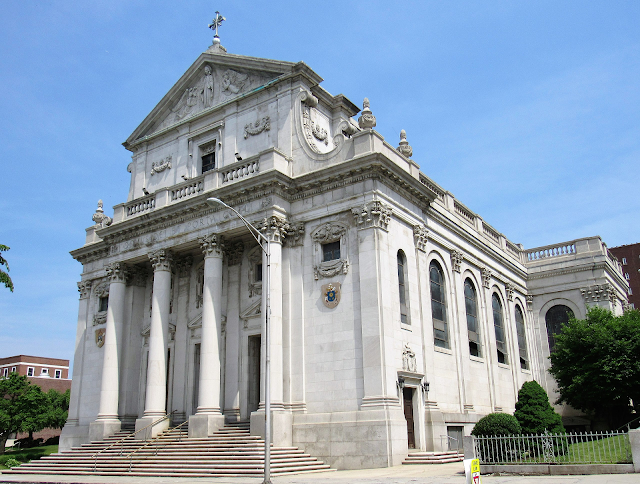The Basilica of the Immaculate Conception in Waterbury, Connecticut was constructed between 1924 - 1928 by the architectural firm of Maginnis and Walsh of Boston. It was in 2008 that it was granted its honorific designation as a 'basilica' by Pope Benedict XVI. (For those not familiar, 'basilica' is a rank that is bestowed by a Roman pontiff on a church deemed to be of particular beauty and importance.)
There has been some suggestion that the basilica's design was based off Santa Maria Maggiore in Rome, but if so, this could only be understood in a very loose sense as there are some clear differences between the two. Still, one can certainly see how it might have taken certain inspirations from Santa Maria Maggiore, particularly where the apse, coffered-style ceiling and ciborium magnum are concerned.

The layout of the basilica is that of a Latin cross (though the two side transepts are quite small so it is almost a technicality). It has the traditional three naves (or in Anglo-American terms, a nave and two side aisles) which are separated by a set of granite Corinthian columns. The basilica also boasts a beautiful coffered, barrel vault ceiling -- one that is more directly reminiscent of that found in St. Peter's in Rome.
What especially stands out to me though are the basilica's beautiful apsidal mosaic and ciborium magnum.

Here too we can certainly see some of that aforementioned influence of Santa Maria Maggiore, not just in the mere fact of the ciborium of course, but in the particulars of its design. It is not a slavish copy of course, but it does utilize a similar colour palette and similar proportions, and much of its gold canopy is based off Santa Maria Maggiore's design as well (especially in its nineteenth century form).
 |
| The ambo/pulpit with medallions containing symbols of the Four Gospels |
One can certainly appreciate why Pope Benedict XVI chose to grant this beautiful and noble edifice the honour of "minor basilica."
-------
Do you like Liturgical Arts Journal's original content? You can help support LAJ in its mission and vision to promote beauty in Catholic worship either by:
You choose the amount! Your support makes all the difference.



















